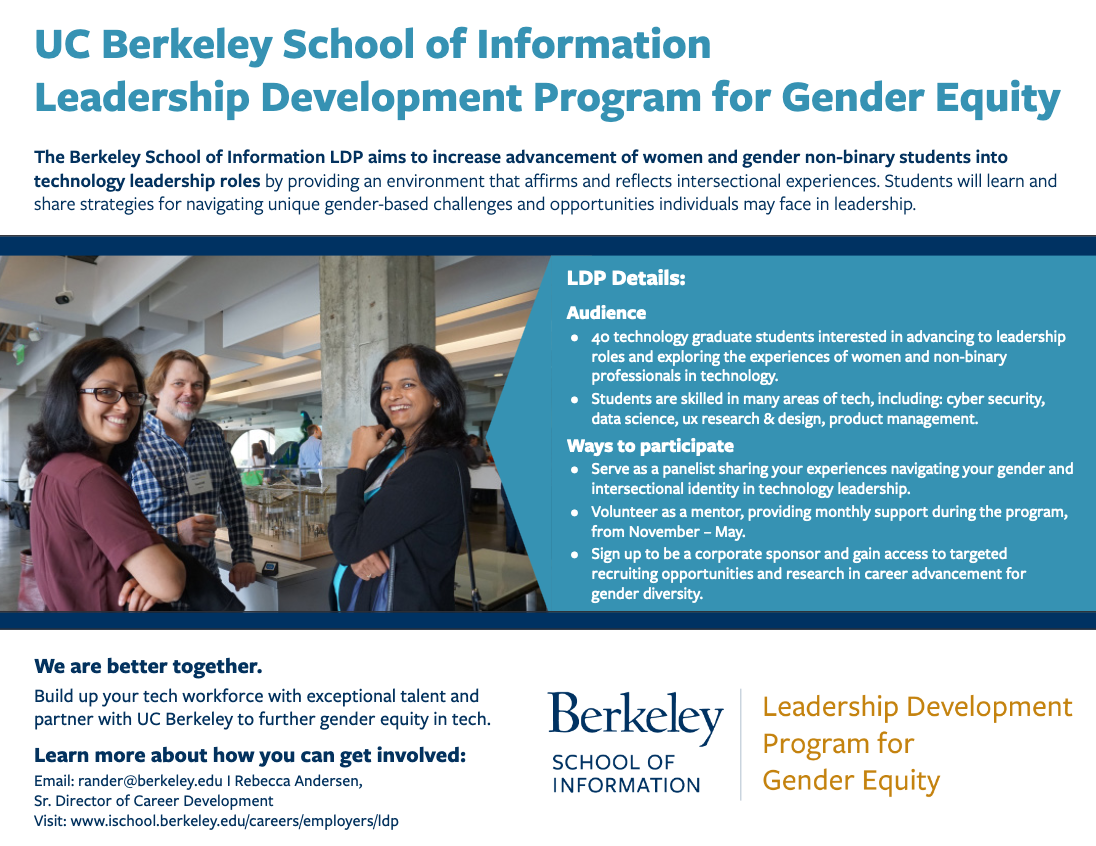School of Information Leadership Development Program for Gender Equity
Research shows gender diverse teams lead to increased financial outcomes1, employee engagement and inclusivity2, and innovative products3. At the same time, women and non-binary professionals face significant challenges in building their career towards technology leadership4.
The School of Information Leadership Development Program (LDP) for Gender Equity aims to increase advancement of women and non-binary students in technology leadership roles through a career development program that affirms and reflects intersectional experiences and builds connections with technology companies.
“Addressing the lack of representation in leadership positions is very important both for the individuals and for companies. A step towards it with programs like these will not only provide training to prepare us for such roles but also a network to share experiences with and learn from each other.”
–Srishti Mehra, MIDS ’22; 2021–22 LDP participant; Machine Learning Engineer, Theorem
The Leadership Development Program includes:
- Student cohort: Cohort of about 40 graduate students interested in technology leadership careers and engaging in dialogue around barriers, biases, and opportunities that women and non-binary professionals face when seeking leadership positions in male-dominated professions.
- Skill-building: Career coaching and workshops building skills to counter gender-based barriers.
- Mentorship: Mentorship with tech leadership who can serve as allies and sponsors.
- Service Learning: Service learning to inspire the next generation of women & non-binary professionals in tech.
- Employer Connections: Connections with employers interested in hiring LDP participants and furthering gender equity in technology careers.
We are better together.
The technology industry is thriving and a career in technology provides the opportunity to shape the future, build up financial equity & stability, and lead a flexible and innovative professional life.
The question is not one of how to get women and non-binary folx interested in these compelling careers, but how we can create a supportive system and environment so they can thrive.
The LDP aims to change the system for the better — we are equipping leaders with equity-driven tools and a supportive community.
Interested in connecting with exceptional talent and partnering to change the face of tech leadership?
Let’s talk!
Support the I School Leadership Development Program
We are actively seeking individuals and organizations who are interested in supporting our female and non-binary students in advancing to technology leadership roles.
Are you an organization interested in supporting our work?
You can participate by:
- Becoming a financial sponsor and corporate partner
- Providing targeted recruiting opportunities
Fill out our form to learn more or find details on corporate sponsorship on our flier.
Are you a leader in technology interested in supporting our female and non-binary students?
You can participate by:
- Volunteering as a one-on-one mentor, committing to regular (e.g., monthly) virtual meetings with a student for a 6-month period, generally November through May
- Serving as a panelist or guest speaker, sharing your experiences navigating gender and intersectional identity factors while advancing to technology leadership
Fill out our form to learn more.
“The Leadership Development Program helps to solidify important leadership concepts such as advocating for yourself and your vision in concrete and impactful ways, taking control of your own career progression, and providing insight to different dimensions of leadership. (Being the greatest at your job isn't nearly all it takes to be a great leader!)”
–Catherine Tsai; 2021–2022 LDP participant; Director of Business Analytics, Houzz
1 Glass, C., & Cook, A. (2018). Do women leaders promote positive change? Analyzing the effect of gender on business practices and diversity initiatives. Human Resource Management, 57(4), 823–837. https://doi.org/10.1002/hrm.21838
2 McKinsey & Company. (2021). Women in the Workplace 2021. https://mck.co/3N7Pfb9
3 Phillips, K. W. (2014, October). How Diversity Makes Us Smarter. Scientific American, 311(4), 42–47. https://bit.ly/3aceuuh;
Triana, M. del C., Richard, O. C., & Su, W. (2019). Gender diversity in senior management, strategic change, and firm performance: Examining the mediating nature of strategic change in high tech firms. Research Policy, 48(7), 1681–1693. https://bit.ly/3t7r84J
4 Moss-Racusin, C. A., Dovidio, J. F., Brescoll, V. L., Graham, M. J., & Handelsman, J. (2012). Science faculty’s subtle gender biases favor male students. Proceedings of the National Academy of Sciences, 109(41), 16474–16479. https://bit.ly/3x3bsjM
Ireland, D. T., Freeman, K. E., Winston-Proctor, C. E., DeLaine, K. D., McDonald Lowe, S., & Woodson, K. M. (2018). (Un)Hidden Figures: A Synthesis of Research Examining the Intersectional Experiences of Black Women and Girls in STEM Education. Review of Research in Education, 42(1), 226–254. https://bit.ly/3NQWCE9
Quadlin, N. (2018). The Mark of a Woman’s Record: Gender and Academic Performance in Hiring. American Sociological Review, 83(2), 331–360. https://doi.org/10.1177/0003122418762291
Cabay, M., Bernstein, B. L., Rivers, M., & Fabert, N. (2018). Chilly Climates, Balancing Acts, and Shifting Pathways: What Happens to Women in STEM Doctoral Programs. Social Sciences, 7(2), 23. https://bit.ly/3tuSnGD
Pew Research Center. (2018). Women and Men in STEM Often at Odds Over Workplace Equity. https://pewrsr.ch/3N9cilW
Twine, F. W. (2018). Technology’s Invisible Women: Black Geek Girls in Silicon Valley and the Failure of Diversity Initiatives. International Journal of Critical Diversity Studies, 1(1), 58–79. https://bit.ly/3lYetNl
McDonald, S. (2011). What You Know or Who You Know? Occupation-specific work experience and job matching through social networks. Social Science Research, 40(6), 1664–1675. https://bit.ly/390pcEa











